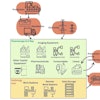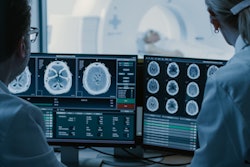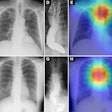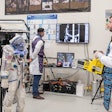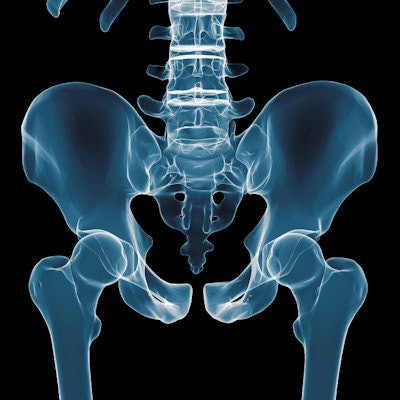
Pushed by radiology's move to digitization and federal reimbursement changes, some 80% of the U.S. installed base of x-ray systems is now based on digital radiography (DR). That's up from 50% in 2015, according to a new report on the digital x-ray market by IMV Medical Information Division.
IMV's "2019 X-ray/DR/CR Market Outlook Report" observes major trends in DR and computed radiography (CR) as radiology's last modality completes the transition to digital imaging. IMV anticipates that over the next three years, about three-quarters of the remaining CR-only systems currently installed are scheduled to be replaced with new DR systems or to be retrofitted using DR detector kits.
And x-ray procedure volume remains high, with more imaging exams being performed on radiography systems in the U.S. than CT, MRI, PET, and nuclear medicine combined.
The last frontier
Classical radiography has always been the last frontier in medical imaging's inexorable transition to digital. In the 1980s, CT and MR scanners revolutionized the imaging industry by generating images digitally rather than using analog/film-based technology. Since then, radiology/imaging departments have progressed to being almost fully digitally based, leaving general radiography as the last modality to digitize.
 Lorna Young of IMV Medical Information Division.
Lorna Young of IMV Medical Information Division.Due to the need for relatively large imaging plates to image large body parts in a single view, such as the chest, the industry had to perfect the image quality of the digital technology and prove it to the radiology community before radiography could complete the transition.
For general x-ray, the adoption of digital technology has gone through several iterations. Initially, the most cost-effective way to affect the transition was to use CR technology, where the x-ray image is acquired digitally onto a phosphor plate that is installed in a cassette similar in size to the film cassette. Once exposed, the CR cassette is physically taken by hospital staff to a CR reader to capture the x-ray image digitally.
With the development of DR technology, the digital x-ray images are acquired directly into a digital detector and instantly transferred to a computer, thereby speeding up the acquisition and processing time for the x-ray images. DR has workflow advantages over CR, but the higher cost of DR technology and the long replacement cycle for x-ray systems ensured that the transition to DR would take time.
As of 2010, just over 25% of the fixed general x-ray systems installed in U.S. hospitals had DR technology, while 70% were CR-only systems and 4% were still film-based. By 2015, DR's share of digital x-ray had grown to half of the installed base of digital x-ray units.
The passage of the Consolidated Appropriations Act of 2016 gave x-ray imaging providers an extra push to continue the transition to DR technology. The legislation mandated that starting in 2017/2018, sites using analog radiography systems -- and even CR units -- would receive lower Medicare and Medicaid reimbursement for the same exams compared with those performed on DR systems.
Looking ahead at the next three years, IMV anticipates about 75% of the remaining CR-only systems currently installed will be scheduled for replacement with new DR systems or be retrofitted using DR detector kits. Some hospitals, such as critical access hospitals, are exempt from the payment reduction mandated by the Consolidated Appropriations Act, so they may be slower to transition. But a number of these hospitals are still planning to replace their CR technology with DR to benefit from the increased productivity of DR technology.
The primary care imaging modality
General radiography is continuing to play a major role as a primary care imaging modality in U.S. hospitals, utilized for inpatients, outpatients, and emergency patients. The top five x-ray procedure types constitute almost 90% of the procedure volume and include the following:
- Chest
- Abdomen
- Pelvis
- Extremities
- Spine
At hospitals, fixed and mobile/portable x-ray systems are located not only in the main radiology department but also in other departments on hospital campuses and in outpatient clinics, imaging centers, and urgent care centers managed by radiology in the hospitals' service areas. As a result -- even though CT, MRI, PET, and nuclear medicine technology have higher visibility as advanced diagnostic imaging modalities -- the number of imaging procedures U.S. hospitals and their associated locations perform on fixed general x-ray systems and mobile/portable x-ray units far exceeds the combined volume of procedures they perform on their CT, MRI, PET, and nuclear imaging systems.
IMV estimates that U.S. hospitals performed a total of 152.8 million procedures on fixed general x-ray systems in 2018, compared with 114.9 million procedures performed using their CT, MR, PET, and nuclear medicine systems -- thereby comprising 57% of the five-modality total of 267.7 million imaging procedures performed by U.S. hospitals (not including procedures performed in independent imaging centers and office practices).
Moreover, IMV estimates that U.S. hospitals performed 61.4 million procedures on mobile/portable general x-ray units, bringing the total number of general x-ray procedures performed in 2018 to an estimated 214.2 million, which accordingly comprises 65% of the five-modality total in U.S. hospitals and their associated locations.
Now that general radiography has joined the ranks of the digital modalities, future artificial intelligence (AI) and machine-learning applications that harness the power of the digital information will be key factors in facilitating further clinical and workflow improvements for radiology. While the adoption of AI applications for clinical decision support using general x-ray data is still in its early stages, radiology administrators see great promise for using such tools to improve image quality output and workflow, and to use as clinical decision support for radiologists.
Lorna Young is senior director of market research at IMV Medical Information Division in Des Plaines, IL.
IMV's "2019 X-ray/DR/CR Market Outlook Report" explores trends in U.S. hospital radiology departments for the adoption rate of CR-to-DR technology; x-ray procedure volume; installed base of fixed and mobile general x-ray DR versus CR systems; x-ray replacement cycles; purchase plans for DR retrofits, and fixed and mobile x-ray systems; manufacturer installed base share and brand loyalty; and site operations characteristics. Respondent opinions on how key issues are affecting their department priorities and outlook are featured, and the report provides five-year market forecast scenarios addressing the fixed general x-ray unit market.
The report is based on responses to an online survey conducted by IMV in January 2019 with 340 radiology administrators/managers in U.S. short-term general hospitals. Their responses have been projected to the IMV-identified universe of over 5,300 hospitals in the U.S. that have at least one fixed general x-ray system installed. For information about purchasing IMV's report, visit the corporate website or call 773-778-3080.
Disclosure notice: IMV Medical Information Division is a sister company of AuntMinnie.com.



